CITROEN C4 CACTUS 2021 Owners Manual
Manufacturer: CITROEN, Model Year: 2021, Model line: C4 CACTUS, Model: CITROEN C4 CACTUS 2021Pages: 256, PDF Size: 7.62 MB
Page 171 of 256

169
FuseNo. Rating
(A) Functions
F30 30Heated rear screen.
F31 10Heated mirrors.
F34 25Trailer inter face unit.
F35 20Trailer inter face unit.
F36 30Front one-touch electric windows.
F37 30Front heated seats.Right-hand fusebox
8
In the event of a breakdown
Page 172 of 256

170
Fuses in the engine
compartment
Access to the fuses
F Unclip the cover.
F C hange the fuse.
F
W
hen you have finished, close the cover
very carefully to ensure correct sealing of
the fusebox. Fuse
No. Rating
(A) Functions
F1 40Air conditioning.
F16 15Front foglamps.
F18 10Right-hand main beam headlamp.
F19 10Left-hand main beam headlamp.
F29 40Windscreen wipers.
The fusebox is placed in the engine
compartment near the battery.
In the event of a breakdown
Page 173 of 256

171
Never try to start the engine by connecting
a battery charger.
Never use a 24 V or higher battery
b o o s t e r.
Check beforehand that the backup
battery has a nominal voltage of 12 V and
a capacity at least equal to that of the
discharged battery.
The two vehicles must not be in contact
with each other.
Switch off all the electrical consumers
on both vehicles (audio system, wipers,
lighting, etc.).
Make sure that the jump leads are not
close to moving parts of the engine (fan,
belts, etc.).
Do not disconnect the (+) terminal while
the engine is running.12 V battery
Procedure for starting the engine using another
battery or charging a discharged battery.
Lead-acid starter batteries
Batteries contain harmful substances
such as sulphuric acid and lead.
They must be disposed of in
accordance with regulations and must
not, in any circumstances, be discarded
with household waste.
Take used remote control batteries and
vehicle batteries to a special collection
point.
Protect your eyes and face before
handling the battery.
All operations on the battery must be
carried out in a well ventilated area and
away from naked flames and sources of
sparks, so as to avoid the risk of explosion
or fire.
Wash your hands afterwards.
Access to the battery
The battery is located under the bonnet.
For access to the (+) terminal:
F
r
elease the bonnet using the interior lever,
then the exterior safety catch,
F
l
ift the bonnet, then fix it in place with its
st ay.
(+) Positive terminal.
It has a quick-release clamp.
(-) Negative terminal.
The negative terminal is not accessible, use the
engine mounting.
Starting using another
battery
When your vehicle's battery is flat, the engine
can be started using a backup battery (external
or from another vehicle) and jump leads or a
battery booster.
8
In the event of a breakdown
Page 174 of 256

172
F Lift the plastic cover on the (+) terminal, if your vehicle has one.
F
C
onnect the red cable to the positive
terminal (+) of the flat battery A (at the metal
elbow) then to the positive terminal (+) of the
backup battery B or the booster.
F
C
onnect one end of the green or black
cable to the negative terminal (-) of the
backup battery B or the booster (or an earth
point on the other vehicle).
F
C
onnect the other end of the green or black
cable to the earth point C on the broken-
down vehicle.
F
S
tart the engine of the vehicle with the
good battery and leave it running for a few
minutes.
F
S
tart the engine on the broken-down vehicle
and let it run.
If the engine does not start straight away,
switch off the ignition and wait a few moments
before trying again.
F
W
ait until the engine returns to idle then
disconnect the jump lead cables in the
reverse order.
F
R
efit the plastic cover to the (+) terminal, if
your vehicle has one.
F
A
llow the engine to run for at least
30
minutes, by driving or with the vehicle
stationary, so that the battery reaches an
adequate state of charge. Some functions, including Stop & Start,
are not available if the battery is not
sufficiently charged.
Charging the battery using
a battery charger
For optimum ser vice life of the battery, it is
essential to maintain an adequate state of
charge.
In some circumstances it may be necessary to
charge the battery:
-
i
f you use your vehicle mostly for short
journeys,
-
i
f the vehicle is to be taken off the road for
several weeks.
Contact a CITROËN dealer or a qualified
workshop.
If you plan to charge your vehicle's battery
yourself, use only a charger compatible
with lead-acid batteries with a nominal
voltage of 12 V.
Follow the instructions provided by the
manufacturer of the charger.
Never reverse polarities. It is not necessary to disconnect the
battery.
F
S
witch off the ignition.
F
S
witch off all electrical consumers (audio
system, lamps, wipers, etc.).
F
S
witch off the charger B before connecting
the cables to the battery, so as to avoid any
dangerous sparks.
F
E
nsure that the charger cables are in good
condition.
F
R
aise the plastic cover, if your vehicle has
one, on the (+) terminal.
F
C
onnect the charger B cables as follows:
-
t
he positive (+) red cable to the (+)
terminal of the battery A ,
-
t
he negative (-) black cable to the earth
point C on the vehicle.
In the event of a breakdown
Page 175 of 256
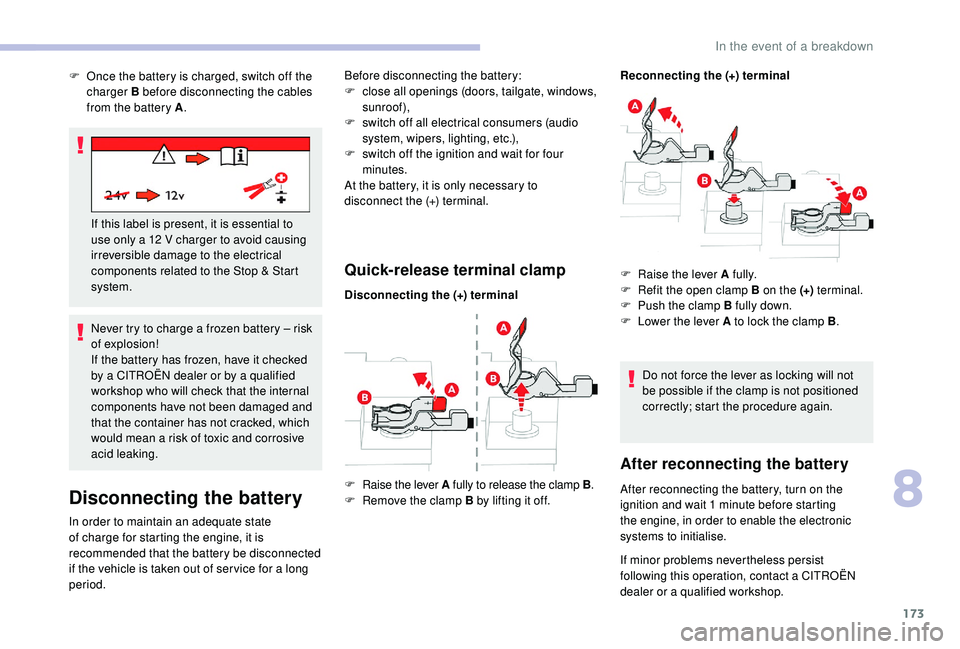
173
Never try to charge a frozen battery – risk
of explosion!
If the battery has frozen, have it checked
by a CITROËN dealer or by a qualified
workshop who will check that the internal
components have not been damaged and
that the container has not cracked, which
would mean a risk of toxic and corrosive
acid leaking.
Disconnecting the battery
In order to maintain an adequate state
of charge for starting the engine, it is
recommended that the battery be disconnected
if the vehicle is taken out of ser vice for a long
period.
Quick-release terminal clamp
Reconnecting the (+) terminalDo not force the lever as locking will not
be possible if the clamp is not positioned
correctly; start the procedure again.
After reconnecting the battery
After reconnecting the battery, turn on the
ignition and wait 1 minute before starting
the engine, in order to enable the electronic
systems to initialise.
F
O
nce the battery is charged, switch off the
charger B before disconnecting the cables
from the battery A .
If this label is present, it is essential to
use only a 12 V charger to avoid causing
irreversible damage to the electrical
components related to the Stop & Start
system. Before disconnecting the battery:
F
c
lose all openings (doors, tailgate, windows,
sunroof),
F
s
witch off all electrical consumers (audio
system, wipers, lighting, etc.),
F
s
witch off the ignition and wait for four
minutes.
At the battery, it is only necessary to
disconnect the (+) terminal.
Disconnecting the (+) terminal
F
Ra
ise the lever A
fully to release the clamp B .
F
R
emove the clamp B by lifting it off. F
Ra
ise the lever A fully.
F
R
efit the open clamp B on the (+)
terminal.
F
P
ush the clamp B fully down.
F
L
ower the lever A to lock the clamp B
.
If minor problems nevertheless persist
following this operation, contact a CITROËN
dealer or a qualified workshop.
8
In the event of a breakdown
Page 176 of 256
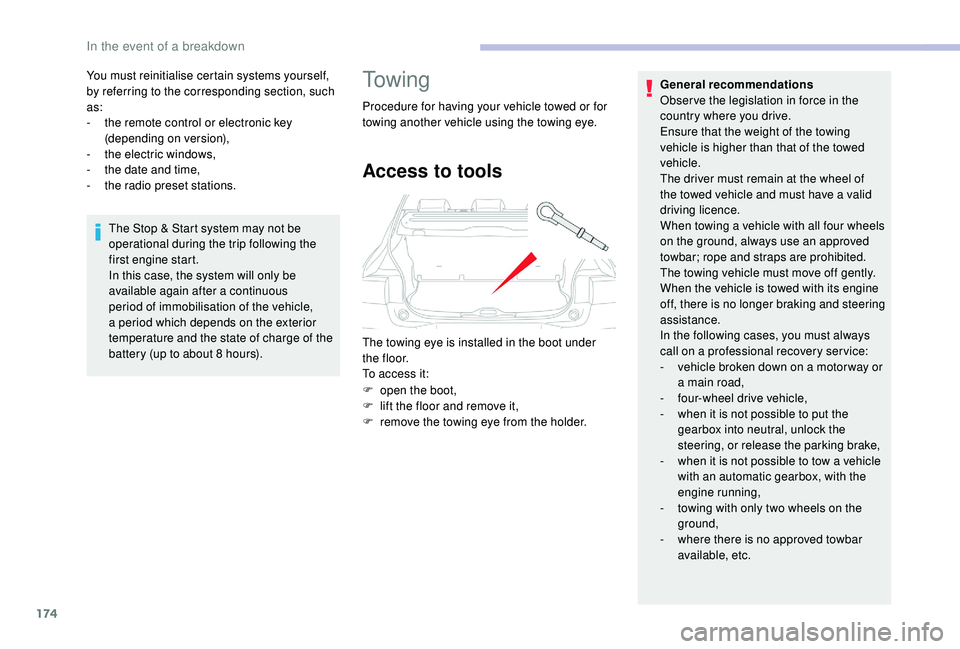
174
You must reinitialise certain systems yourself,
by referring to the corresponding section, such
as:
-
t
he remote control or electronic key
(depending on version),
-
t
he electric windows,
-
t
he date and time,
-
t
he radio preset stations.The Stop & Start system may not be
operational during the trip following the
first engine start.
In this case, the system will only be
available again after a continuous
period of immobilisation of the vehicle,
a period which depends on the exterior
temperature and the state of charge of the
battery (up to about 8 hours).To w i n g
Procedure for having your vehicle towed or for
towing another vehicle using the towing eye.
Access to tools
The towing eye is installed in the boot under
t h e f l o o r.
To access it:
F
o
pen the boot,
F
l
ift the floor and remove it,
F
r
emove the towing eye from the holder. General recommendations
Obser ve the legislation in force in the
country where you drive.
Ensure that the weight of the towing
vehicle is higher than that of the towed
vehicle.
The driver must remain at the wheel of
the towed vehicle and must have a valid
driving licence.
When towing a vehicle with all four wheels
on the ground, always use an approved
towbar; rope and straps are prohibited.
The towing vehicle must move off gently.
When the vehicle is towed with its engine
off, there is no longer braking and steering
assistance.
In the following cases, you must always
call on a professional recovery ser vice:
-
v
ehicle broken down on a motor way or
a main road,
-
f
our-wheel drive vehicle,
-
w
hen it is not possible to put the
gearbox into neutral, unlock the
steering, or release the parking brake,
-
w
hen it is not possible to tow a vehicle
with an automatic gearbox, with the
engine running,
-
t
owing with only two wheels on the
ground,
-
w
here there is no approved towbar
available, etc.
In the event of a breakdown
Page 177 of 256

175
Towing your vehicle
Failure to obser ve this instruction could
result in damage to certain components
(braking, transmission, etc.) and the
absence of braking assistance the next
time the engine is started.F
M
ove off gently, drive slowly and for a short
distance.
Towing another vehicle
F On the front bumper, unclip the cover by pressing at the bottom.
F
S
crew the towing eye in fully.
F
I
nstall the towbar.
F
W
ith a manual gearbox, move the gear lever
into neutral.
F
W
ith an automatic or electronic gearbox,
place the gear selector in position N .
F
U
nlock the steering and release the parking
brake.
F
S
witch on the hazard warning lamps on
both vehicles. F
O
n the rear bumper, unclip the cover by
pressing at the bottom.
F
S
crew the towing eye in fully.
F
I
nstall the towbar.
F
S
witch on the hazard warning lamps on
both vehicles.
F
M
ove off gently, drive slowly and for a short
distance.
8
In the event of a breakdown
Page 178 of 256
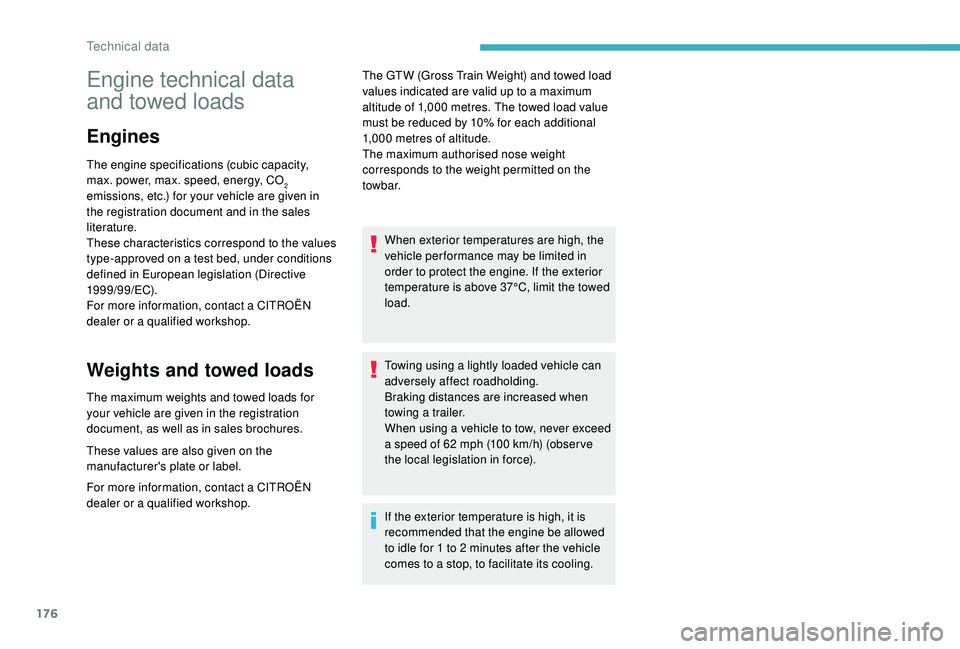
176
Engine technical data
and towed loads
Engines
The engine specifications (cubic capacity,
max. power, max. speed, energy, CO
2
emissions, etc.) for your vehicle are given in
the registration document and in the sales
literature.
These characteristics correspond to the values
type-approved on a test bed, under conditions
defined in European legislation (Directive
1999/99/EC).
For more information, contact a CITROËN
dealer or a qualified workshop.
Weights and towed loads
The maximum weights and towed loads for
your vehicle are given in the registration
document, as well as in sales brochures.
These values are also given on the
manufacturer's plate or label.
For more information, contact a CITROËN
dealer or a qualified workshop. The GTW (Gross Train Weight) and towed load
values indicated are valid up to a maximum
altitude of 1,000 metres. The towed load value
must be reduced by 10% for each additional
1,000 metres of altitude.
The maximum authorised nose weight
corresponds to the weight permitted on the
towbar.
When exterior temperatures are high, the
vehicle per formance may be limited in
order to protect the engine. If the exterior
temperature is above 37°C, limit the towed
load.
Towing using a lightly loaded vehicle can
adversely affect roadholding.
Braking distances are increased when
towing a trailer.
When using a vehicle to tow, never exceed
a speed of 62 mph (100 km/h) (obser ve
the local legislation in force).
If the exterior temperature is high, it is
recommended that the engine be allowed
to idle for 1 to 2 minutes after the vehicle
comes to a stop, to facilitate its cooling.
Technical data
Page 179 of 256
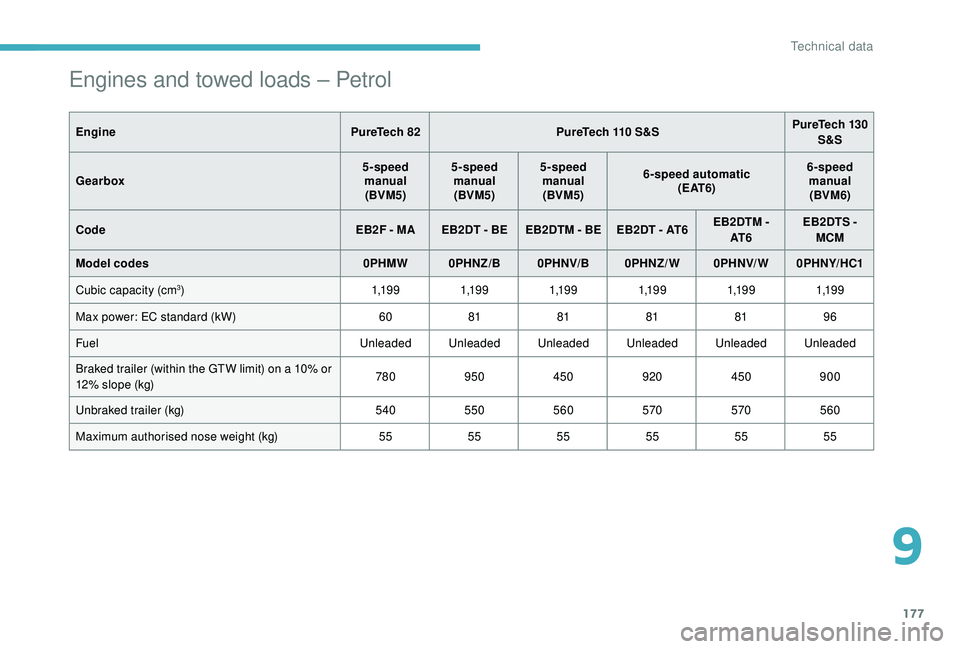
177
Engines and towed loads – Petrol
EnginePureTech 82PureTech 110 S&S PureTech 130
S&S
Gearbox 5-speed
manual(BVM5) 5-speed
manual(BVM5) 5-speed
manual(BVM5) 6-speed automatic
( E AT 6 ) 6-speed
manual(BVM6)
Code EB2F - MA EB2DT - BE EB2DTM - BE EB2DT - AT6 EB2DTM -
AT 6 EB2DTS -
MCM
Model codes 0PHMW 0PHNZ/B 0PHNV/B0PHNZ/ W0PHNV/ W0PHNY/HC1
Cubic capacity (cm
3) 1,1 9 91,1 9 91,1 9 91,1 9 91,1 9 91,1 9 9
Max power: EC standard (kW) 608181818196
Fuel Unleaded Unleaded Unleaded Unleaded Unleaded Unleaded
Braked trailer (within the GTW limit) on a 10% or
12% slope (kg) 780
950 450 920450900
Unbraked trailer (kg) 540550560 570570560
Maximum authorised nose weight (kg) 555555555555
9
Technical data
Page 180 of 256
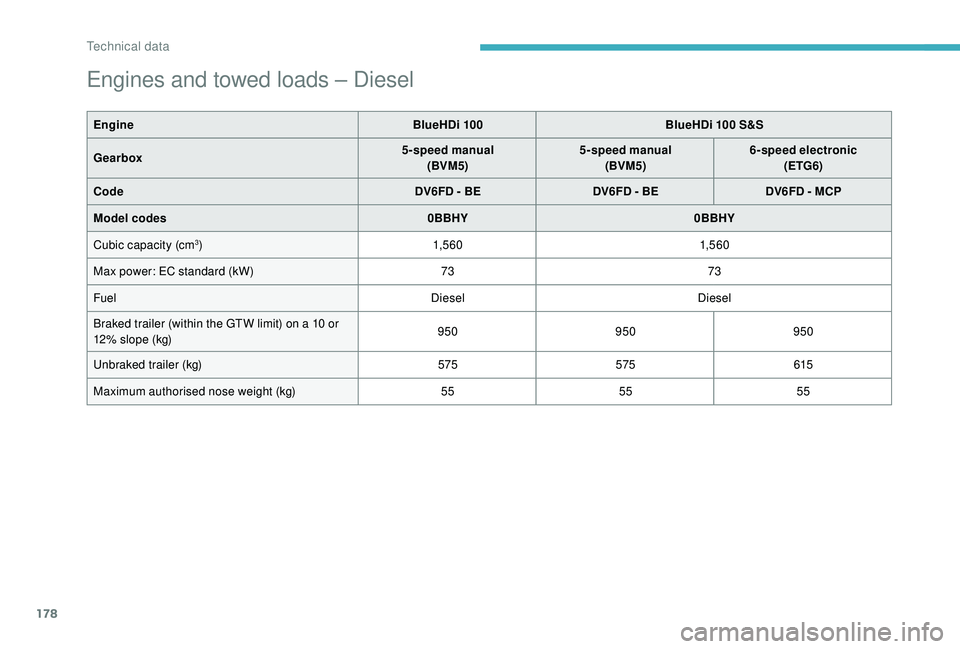
178
Engines and towed loads – Diesel
EngineBlueHDi 100BlueHDi 100 S&S
Gearbox 5-speed manual
(BVM5) 5-speed manual
(BVM5) 6-speed electronic
(ETG6)
Code DV6FD - BEDV6FD - BEDV6FD - MCP
Model codes 0BBHY0BBHY
Cubic capacity (cm
3) 1,5 6 0 1,5 6 0
Max power: EC standard (kW) 7373
Fuel DieselDiesel
Braked trailer (within the GTW limit) on a 10 or
12% slope (kg) 950
950950
Unbraked trailer (kg) 575575 615
Maximum authorised nose weight (kg) 555555
Technical data